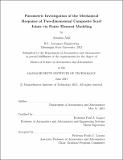| dc.contributor.advisor | Paul A. Lagacé. | en_US |
| dc.contributor.author | Adil, Arsalan | en_US |
| dc.contributor.other | Massachusetts Institute of Technology. Department of Aeronautics and Astronautics. | en_US |
| dc.date.accessioned | 2015-09-17T17:44:35Z | |
| dc.date.available | 2015-09-17T17:44:35Z | |
| dc.date.copyright | 2015 | en_US |
| dc.date.issued | 2015 | en_US |
| dc.identifier.uri | http://hdl.handle.net/1721.1/98587 | |
| dc.description | Thesis: S.M., Massachusetts Institute of Technology, Department of Aeronautics and Astronautics, 2015. | en_US |
| dc.description | This electronic version was submitted by the student author. The certified thesis is available in the Institute Archives and Special Collections. | en_US |
| dc.description | Cataloged from student-submitted PDF version of thesis. | en_US |
| dc.description | Includes bibliographical references (pages 263-265). | en_US |
| dc.description.abstract | A parametric investigation was conducted in order to characterize the mechanical response of two-dimensional composite scarf joints subjected to extensional loading, to determine the associated response sensitivities to joint parameters, and to establish the fundamental operative joint mechanics. The geometric parameters of equal scarf angles, adhesive thickness, and unequal scarf angles, and the laminate parameter of similar laminate configurations of both adherends of [+/-[theta]₂/0₂]S, [[theta]/0=0]₂S, and homogenized [[theta]₂/0₂]S (equivalently homogeneously orthotropic) were explored for values of [theta] of 45° and 15°. The ply regions of the laminates were modeled as transversely isotropic T700/2510 carbon/epoxy composite material, and the adhesive region as isotropic FM 300-2K polymer film adhesive. Linear elastic plane strain analyses were performed via finite element modeling. The results indicate that the overall mechanical response of two-dimensional composite scarf joints in the joint region is influenced by the global/macroscopic joint features of 'effective' through-thickness stiffness properties of the configuration in the joint region, and equilibrium considerations along the bondline, and by the local joint features manifested at the tips of the adherends at the ends of the joint region and through ply-by-ply level mismatch in stiffness properties within the adherend. The global peaks in the magnitudes of strains occur in the adhesive, and the distributions of strains in the adhesive essentially reflect the distributions of strains along the bondline in the adherend. The distributions of strains in the adherend along the bondline reflect the distribution of stiffness properties of the adherend through the thickness, and are governed by the local effects of mismatch in stiffness properties between the [theta] and 0° plies along with the lengthscale of the effective ply thickness. Sharp changes in the magnitudes of strains occur near the acute and obtuse tips of the adherend, and these are related to the overall length-scales of the configuration and show similar aspects to those occurring in laminated structures with ply drop-offs. The magnitudes of strains show the greatest sensitivity to variations in the scarf angle of the configuration, increasing with increasing values of scarf angle and associated changes in bondline length, but show little sensitivity to variations in the adhesive thickness of the configuration. For the asymmetric configurations of unequal scarf angles, the response characteristics exhibit combined effects of variations in scarf angles and adhesive thickness, and exhibit signicant asymmetry in the cross-sectional distribution of far-field longitudinal strain. Recommendations for further work are presented. | en_US |
| dc.description.statementofresponsibility | by Arsalan Adil. | en_US |
| dc.format.extent | 265 pages | en_US |
| dc.language.iso | eng | en_US |
| dc.publisher | Massachusetts Institute of Technology | en_US |
| dc.rights | M.I.T. theses are protected by copyright. They may be viewed from this source for any purpose, but reproduction or distribution in any format is prohibited without written permission. See provided URL for inquiries about permission. | en_US |
| dc.rights.uri | http://dspace.mit.edu/handle/1721.1/7582 | en_US |
| dc.subject | Aeronautics and Astronautics. | en_US |
| dc.title | Parametric investigation of the mechanical response of two-dimensional composite scarf joints via finite element modeling | en_US |
| dc.type | Thesis | en_US |
| dc.description.degree | S.M. | en_US |
| dc.contributor.department | Massachusetts Institute of Technology. Department of Aeronautics and Astronautics | |
| dc.identifier.oclc | 921146766 | en_US |
